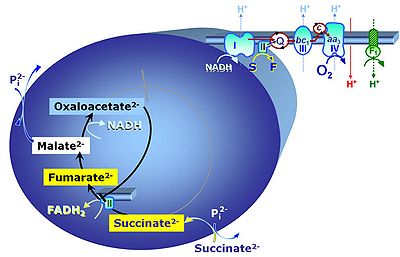Difference between revisions of "Succinate"
| Line 3: | Line 3: | ||
|description=[[File:Succinic_acid.jpg|left|100px|Succinic acid]] | |description=[[File:Succinic_acid.jpg|left|100px|Succinic acid]] | ||
'''Succinic acid''', C<sub>4</sub>H<sub>6</sub>O<sub>4</sub>, occurs under physiological conditions as the anion '''succinate<sup>2-</sup>, S''', with ''p''K<sub>a1</sub> = 4.2 and ''p''K<sub>a2</sub> = 5.6. | '''Succinic acid''', C<sub>4</sub>H<sub>6</sub>O<sub>4</sub>, occurs under physiological conditions as the anion '''succinate<sup>2-</sup>, S''', with ''p''K<sub>a1</sub> = 4.2 and ''p''K<sub>a2</sub> = 5.6. | ||
Succinate is formed in the [[TCA cycle]], and is a substrate of [[ | Succinate is formed in the [[TCA cycle]], and is a substrate of [[Complex II |C<sub>II</sub>]], reacting to [[fumarate]] and feeding electrons into the [[Q-junction]]. Succinate (C<sub>II</sub>-linked) and NADH (C<sub>I</sub>-linked) provide convergent electron entries into the Q-junction. Succinate is transported across the inner mitochondrial membrane by the [[dicarboxylate carrier]]. Incubation of mt-preparations by succinate alone may lead to accumulation of [[oxaloacetate]], which is a potent inhibitor of Complex II (compare [[Succinate and rotenone]]). [[Malic enzyme]] (mtME) may prevent accumulation of oxaloacetate. | ||
|info=[ | |info=[[Gnaiger 2012 MitoPathways]] | ||
|type=Respiration | |type=Respiration | ||
}} | }} | ||
| Line 13: | Line 13: | ||
|type=Respiration | |type=Respiration | ||
}} | }} | ||
[[File:S.jpg|400px|thumb|Succinate, S. From [[Gnaiger 2014 MitoPathways]].]] | |||
== Application in [[HRR]] == | == Application in [[HRR]] == | ||
| Line 28: | Line 29: | ||
'''Oxygraph-2k manual titrations''' [[MiPNet09.12 O2k-Titrations]] | '''Oxygraph-2k manual titrations''' [[MiPNet09.12 O2k-Titrations]] | ||
::* In the absence of | ::* In the absence of C<sub>I</sub>-linked substrates, add the C<sub>I</sub>-inhibitor [[rotenone]] before addition of succinate, to avoid accumulation of [[oxaloacetate]] with subsequent inhibition of succiante dehydrogenase. See: [[Succinate and rotenone]]. | ||
::* When keeping the succinate stock solution on ice, check for complete solubilization of succinate and warm in your hands if necessary. | ::* When keeping the succinate stock solution on ice, check for complete solubilization of succinate and warm the stock solution in your hands if necessary. | ||
::* Titration volume: 20 µl using a 50 µl syringe (2 ml O2k-chamber). | ::* Titration volume: 20 µl using a 50 µl syringe (2 ml O2k-chamber). | ||
::* Final concentration: 10 mM. | ::* Final concentration: 10 mM. | ||
Revision as of 17:44, 9 August 2014
Description
Succinic acid, C4H6O4, occurs under physiological conditions as the anion succinate2-, S, with pKa1 = 4.2 and pKa2 = 5.6. Succinate is formed in the TCA cycle, and is a substrate of CII, reacting to fumarate and feeding electrons into the Q-junction. Succinate (CII-linked) and NADH (CI-linked) provide convergent electron entries into the Q-junction. Succinate is transported across the inner mitochondrial membrane by the dicarboxylate carrier. Incubation of mt-preparations by succinate alone may lead to accumulation of oxaloacetate, which is a potent inhibitor of Complex II (compare Succinate and rotenone). Malic enzyme (mtME) may prevent accumulation of oxaloacetate.
Abbreviation: S
Reference: Gnaiger 2012 MitoPathways
MitoPedia topics: Substrate and metabolite

Application in HRR
S: Succinate (Succinate disodium salt, hexahydrate, C4H404Na2 * (H2O)6); Sigma S 2378, 100 g, store at RT; FW = 270.1
Preparation of 1 M stock solution (dissolved in H2O):
- 1) Weigh 1.3505 g of succinate and dissolve in 3 ml H2O.
- 2) Check pH and adjust to 7.0 if necessary with 1 N HCl (usually the pH is 7 without any adjustment).
- 3) Transfer to 5 ml volumetric glass flask and adjust the final volume to 5 ml.
- 4) Divide into 0.5 ml portions.
- 5) Store frozen at -20 °C.
Oxygraph-2k manual titrations MiPNet09.12 O2k-Titrations
- In the absence of CI-linked substrates, add the CI-inhibitor rotenone before addition of succinate, to avoid accumulation of oxaloacetate with subsequent inhibition of succiante dehydrogenase. See: Succinate and rotenone.
- When keeping the succinate stock solution on ice, check for complete solubilization of succinate and warm the stock solution in your hands if necessary.
- Titration volume: 20 µl using a 50 µl syringe (2 ml O2k-chamber).
- Final concentration: 10 mM.

